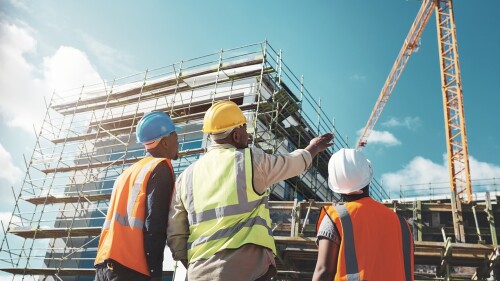Builders are competing to create the tallest residential structure in Philadelphia.
The condominiums and hotel rooms at the SLS Lux Philadelphia Hotel and Residences will loom 556 feet (169 m) over the Center City neighborhood when it finally opens in 2017.
“It will be an exclamation point over downtown,” says Carl Dranoff, president of Dranoff Properties, the lead developer for the 42-story tower.
It seemed like a tall building when it was approved in 2014. But in November, renderings were leaked on the public forum page of Skyscraper- Page.com of a taller, 600-foot (183 m) residential tower planned for 1911 Walnut Street, also in Center City, by developer Southern Land Company, based in Nashville, Tennessee.
New high rises will bring thousands of apartments and condos to downtown Philadelphia over the next year, adding to the neighborhood of offices, restaurants, and concert halls that has grown in Center City over the last 20 years. Each part of the mixed-use district supports the other parts.
“It’s great to see so many cranes in the sky,” says Anne Fadullon, the city’s new director of planning and development—the first person to ever hold that title; the position was created this year.
A Growing Population
Starting in 2006, the city of Philadelphia’s population began to grow for the first time in 50 years, according to the U.S. Census Bureau.
Nearly all of the growth is concentrated downtown and in the neighborhoods nearby. Between 2000 and 2014, Center City’s population grew 16 percent, to exceed 183,000. Center City has more residents than any other U.S. downtown except midtown Manhattan. That puts Center City ahead of downtown Chicago, Boston, and San Francisco in population, according to the Center City District, a private sector business improvement district founded in 1990 by business leaders and local officials.
For most of that time, the dwindling population in the rest of Philadelphia offset Center City’s growth. In neighborhoods across the city, owners continue to abandon properties, and many city blocks in north Philadelphia that once were lined with townhouses are empty fields of grass.
“We’ve gained a lot of population in Center City,” says Kevin Gillen, chief economist in the Philadelphia office of Meyers Research, an apartment research firm and consultancy. “Other parts of the city still lost population.”
This growth in Center City is driving a boom in apartment construction throughout the Philadelphia metropolitan area.
Developers opened thousands of new apartments in 2015 in Greater Philadelphia, increasing the total inventory of apartments by 1.5 percent from the year before, according to Reis, a national apartment research firm based in New York City.
More new apartments opened in the metro area in 2015 than in any other year since Reis started keeping records in 1980—and even more new apartments are coming. “Inventory growth could hit 1.6 percent in 2016,” says Michael Steinberg, a senior analyst for Reis.
Much of the new construction is concentrated in Center City, where developers completed 1,983 new residential units in 2014, almost as many as the record 2,168 units they finished in 2013, according to the Center City District.
“Whole blocks downtown are being redeveloped for commercial, retail, and residential,” says Laurie Olin, partner with OLIN, a landscape design firm based in Philadelphia specializing in commercial real estate. For years, he designed projects in far-away places like San Francisco and Great Britain. Now, Olin’s firm is busy working in its hometown.
The projects underway may be a lot for Philadelphia, but it is a relatively slow rate of growth compared with that seen in other major U.S. apartment markets. For example, the inventory of apartments in Philadelphia did not grow as much as the overall inventory of apartments across the United States, which grew 1.9 percent in 2015. Developers were also much busier in the Houston metro area, where the apartment inventory grew 2.9 percent in 2015. Phoenix experienced a 2 percent inventory growth.
“For Philadelphia, it’s a boom. For the rest of the country, it’s a boomlet,” Fadullon says.
However, such growth is causing some concern. “Now, people are maybe worried about saturation,” says Antonio Fiol-Silva, an architect with the Philadelphia office of Wallace Roberts & Todd. “This wave of development may take some time to be absorbed.”
So far, there are very few empty apartments in Philadelphia. Only 3.5 percent of the apartments in the metro area were vacant in the fourth quarter of 2015. A 1.6 percent increase to the apartment inventory would leave the market in a healthy position even if demand for apartments were to flatten.
Advantage Center City
The demand for apartments and condominiums in Philadelphia has deep roots. Center City offers a bustling job market, transportation options, and entertainment.
Philadelphia has benefited from a long, slow transformation from a low point in the early 1990s. “Twenty years ago, if you went out in the street, there weren’t a lot of people around,” says Olin, whose office is next to Independence Hall in Center City.
Now, Center City is bustling. More than 300 cafés and restaurants offer outside seating, with patrons spilling out onto the sidewalk during the warmer months. That is up from just a few dozen back in 2001; Philadelphia first allowed outside restaurant seating in 1995.
Tourism is strong as well. The hotel rooms in Center City had an average daily occupancy rate of 75.5 percent in 2014, exceeding the 73.5 percent peak set during the last economic boom in 2006.
Dranoff Properties is building its SLS Residences partly to take advantage of the bustling scene downtown. The tower will include 150 luxury hotel rooms, in addition to the 90 condominium units that will fill the top floors.
The tower will rise in the heart of Philadelphia’s downtown arts district, on the same block as the Kimmell Center, a performing-arts complex that includes the Merriam Theatre, and the Academy of Music concert hall and opera house.
These attractions are helping Center City’s apartment developers convince more of the young people who attend college nearby to live downtown for a few years after graduation. “Young people come to school here, get a job, and then they stay,” Dranoff says.
Statistics compiled by the Center City District show that 116,000 young people are enrolled in colleges and universities close to downtown, including Drexel University and the University of Pennsylvania, both of which are just across the Schuylkill River from Center City, and Temple University just to the north.
This clustering creates a virtuous cycle, in which a concentration of good jobs attracts workers with good skills to come and live near their jobs, filling the new apartments, townhouses, and condos in and around Center City, which, in turn, attracts more employers.
The universities near downtown also are creating jobs. “They are giant job machines; a lot of knowledge workers are there,” Dranoff says. These jobs attract more residents, and the virtuous cycle continues.
“Employers will always follow the employees in the quest to find a high-quality workforce,” says John Gattuso, regional director and senior vice president for the urban region for Liberty Property Trust, which is building the new Comcast Innovation and Technology Center, now rising over downtown Philadelphia, which is expected to bring an estimated 2,800 new office jobs downtown.
“Employers will see Philadelphia as a place they need to be,” Gattuso says. It is a huge change from just two decades ago, when Liberty owned no properties in Center City, even though it is based in nearby Malvern, Pennsylvania. “Making a substantial investment in Philadelphia’s core would have been a very tough decision in 1995,” he says. “We’ve had a total reversal.”
Leaving the Empty Nest
The growing population downtown also includes older residents, including empty nesters who are beginning to sell their homes in the suburbs to move into smaller living spaces in Center City.
“These suburban empty nesters don’t want steps anymore. They want to be in the city to enjoy their lives,” Dranoff says. “They have a tremendous impact on our business.”
Philadelphia’s developers are building new condos for the first time since the collapse of the housing bubble, partly to attract these older potential residents.
The tall tower that Southern Land has proposed for 1911 Walnut Street will fit 64 to 75 condo units, in addition to 342 rental apartments, into its 47 to 51 stories. Southern Land is still negotiating with city officials about the scope of the project.
Dranoff’s tower of new condos, One Riverside, along the banks of the Schuylkill River in Center City, is scheduled to top out in May. More than half of the condo space has already been sold; buyers include many older homeowners, Dranoff says, and these buyers are already changing the floor plans from what the developers had in mind. He originally set out to create 82 luxury condos with an average size of 1,500 square feet (139 sq m). The buyers, however, have other ideas: Many are bidding for multiple condo units and merging them to create larger homes with 2,500 to 3,000 square feet (232 to 279 sq m).
“They are bringing their own designs,” Dranoff says. The finished building will probably have only 60 condos with an average size of 2,500 square feet (232 sq m). “We’ve sold one 4,000-square-foot [372 sq m] unit for $4 million.” Homeowners are expected to move into the finished, $98 million One Riverside building in spring 2017.
Supporting Development
Consistent support from the city of Philadelphia has helped developments like One Riverside. To begin with, Dranoff’s riverside buildings might not have happened had Philadelphia not created its Schuylkill River Park at the foot of the building, along with the Schuylkill River Boardwalk, a new walking path along the river that extends over the waterway. (See the related article on page 200.)
“The park gave us the impetus to do our buildings on the Schuylkill River,” Dranoff says. His very first property, Locust on the Park, next to Schuylkill River Park, opened in 1999 with 152 rental apartments. He planned the building as the city planned its riverside park.
Once Dilworth Park opened in 2014 next to City Hall, 94 percent of the Center City core had access to green open space within a quarter-mile (0.4 km) walk, according to the Center City District, which has supported a variety of policies and programs to help downtown.
“The turning point for downtown was 25 years ago with the creating of the Center City District,” Gillen says.
Philadelphia also supports new development with a generous ten-year property tax abatement. If property owners finish a substantial renovation or new development in the city, they do not have to pay taxes on the value of the improvement for ten years. Soon after the abatement became law, between 2002 and 2004, development in the city more than quadrupled.
A recent study by Jones Lang LaSalle found that the tax abatement is still necessary to encourage development in Philadelphia. Any short-term benefit to Philadelphia’s budget from ending the tax abatement would be overcome by a lack of development within seven years.
“We can’t really pursue these activities without the abatement,” Fadullon says.
Another study, this one from Philadelphia’s Lindy Institute for Urban Innovation at Drexel University, finds that for every dollar in tax revenue that Philadelphia loses because of the abatement, the city gains $2 from the taxable economic activity supported by new developments and renovations.
The School Question
Policy makers now hope to continue the growth of the neighborhood by improving Philadelphia’s school system.
Since 2000, almost 30,000 children have been born to Center City parents, according to the Center City District. There were 2,252 births to Greater Center City parents in 2014, up 4.16 percent from the year before and up 40 percent from 2000.
But the public school system in Philadelphia is deeply troubled, according to local experts, and that will make it harder for these urban parents. “The biggest question for Philadelphia is whether millennials can be convinced to stay in the city once they are married and have kids,” Gillen says.
Policy makers are also trying to spread the success of Center City to adjacent neighborhoods—and further away.
“The changes are occurring in a very small part of a very large city,” says Harris Steinberg, executive director of the Lindy Institute. “There are vast parts of the city that haven’t experienced many changes and are still in decline.”
Drexel and the University of Pennsylvania are both deeply involved in helping their neighborhoods. In 2001, the latter opened Penn Alexander, a neighborhood public school now serving more than 500 students. Drexel is now planning to build its own neighborhood school in west Philadelphia. Both schools also help their employees buy homes near campus.
The city also created the Philadelphia Land Bank in 2013, which recently received several hundred vacant properties from other municipal agencies in the hope that eventually the properties will be redeveloped. “A lot of these sites have been in public ownership for literally decades,” Fadullon says.
Meanwhile, the boom in Center City is slowly spreading as developers announce new luxury projects in the neighborhoods next door. Just a few blocks north of the edge of Center City, workers are converting the old Divine Lorraine Hotel into 126 new, Class A rental apartments. Developer Eric Blumenfeld broke ground on the renovation in September.
Westrum Development, based in Fort Washington, Pennsylvania, still plans to build 250 townhouses on lots it owns in the Brewerytown neighborhood, just northwest of Center City, and another 50 units in the Bella Vista neighborhood, just southeast of Center City.
“Philadelphia is being built one to 20 units at a time,” says John Westrum, chief executive officer of the company.
Bendix Anderson writes about commercial real estate, sustainable development, and affordable housing.










